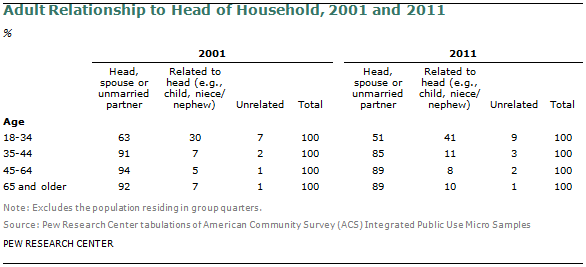Much of the analysis in the report focuses on the households headed by those younger than 35. Between 2001 and 2011, the composition of households headed by those younger than 35 has changed. Young adults are less likely to form independent households, and Census Bureau data suggest that young adults in independent households are a select group. Young adults in independent households tend to be the more economically successful young adults.

Regarding the change in composition, using the American Community Survey, we can classify young adults by the nature of their relationship to the head of the household.7 The young adult may be in an independent household in that the young adult may be either the head, spouse of the head, or the unmarried partner of the head of the household. Alternatively, the young adult may be residing with family (other than spouse) in that the young adult may be the child, child-in-law, niece/nephew, sibling, grandchild or other relative of the head. Finally, the young adult may be residing independently of family by living with a roommate or being a boarder or lodger of the head of the household.
There has been compositional change in young adult households in that fewer young adults are living independently and more are residing with family. In 2001, 30% of young adults were related to the head (other than spouse) and not living independently. By 2011, 41% of young adults were residing with family (other than spouse). The Census data show that adults of all ages were more likely to reside with family (other than spouse) in 2011 than in 2001, but the decline in independent living was greatest among young adults.

ACS data from 2011 indicate that living independently of family is associated with higher educational attainment and labor market earnings. Young adults who fare better in the labor market are more likely to not live with family (other than spouse). Young adults related to the head of the household tend to be much younger, and thus it is instructive to examine the characteristics of young adults in two age breakdowns: 24 or younger and 25 to 34. In either age group, young adults residing independently of family (either the head/spouse/unmarried partner or roommate/boarder/lodger) tend to be better educated and more likely to be employed at the date of interview, and they report higher earned income. For example, 36% of young adults age 25 to 34 who live independently of kin have at least a bachelor’s degree, while only 21% of their peers residing with kin have at least that level of education.
So, the analysis based on households takes the households as formed as given, but, admittedly the young adult households in 2010 or 2011 are more selected economically at the end of the decade than in 2001. That is, the young adult households observed at the end of the decade tend to have higher incomes, are more likely own their own homes, and are more likely to be in debt. The compositional changes that have occurred are likely leading us to understate the decline in homeownership and indebtedness that has occurred.


